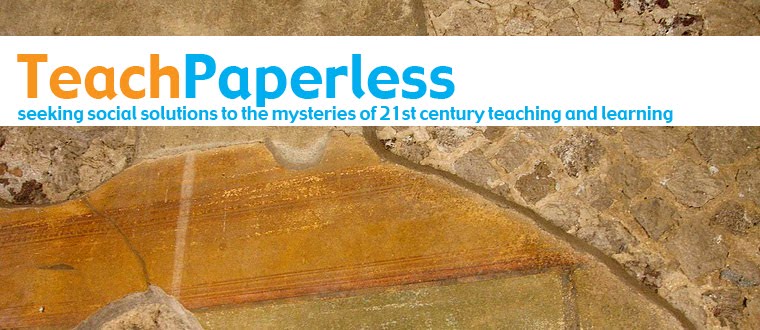College leaders usually brag about their tech-filled "smart" classrooms, but a dean at Southern Methodist University is proudly removing computers from lecture halls. José A. Bowen, dean of the Meadows School of the Arts, has challenged his colleagues to "teach naked"—by which he means, sans machines.
And what is the cause of this new Luddite movement? Fear of social media breaking down traditional classroom hierarchies? Confusion over cloud computing and the meltdown in sales of proprietary software packages? Concern over mobile computing and Wi-Fi devices disturbing class?
No. None of that.
More than any thing else, Mr. Bowen wants to discourage professors from using PowerPoint, because they often lean on the slide-display program as a crutch rather using it as a creative tool.
PowerPoint.
Seriously?
Um. Yeah. Seriously.
Haven't most of us realized for a long time that PP is rather limited? Isn't that part of the reason we've been bringing active media into our classrooms for a while now?
I don't know, maybe this is just a K-12 teacher vs. college teacher thing, but I kinda thought everyone already KNEW lectures were by-and-large yawn-fests.
[If you have Diigo installed (and face it, by now you have no reason not to), go bookmark and check out the meta-analysis battle going on over the Chronicle report.]
So, what's Bowen's big idea?
His philosophy is that the information delivery common in today's classroom lectures should be recorded and delivered to students as podcasts or online videos before class sessions.
Uh.
Duh?
I don't mean to be so obviously disrespectful, but I can't quite put into words how I feel about this. In one respect, I find it deeply funny. In another deeply disturbing.
I mean, this is all so... obvious.
Rather than try to re-construe, here are the comments I left over at the Dig Ed blog:
PowerPoint is hardly state of the art 'technology'.
PowerPoint presentations are precisely the sort of things so many of us in ed tech are trying to steer folks away from.
So I guess, in that sense, me and the dean are in agreement. Power Point often leads to a passive audience watching a lecture.
Where we disagree is in the 'naked' classroom concept. And this has to do with the fact that if the dean thinks PowerPoint is what we're talking about when we're talking about technology, then he's only demonstrating that he has no idea about what technology is.
We're talking social media, cloud computing, mobile applications.
Tech that actively integrates into learning.
Sounds like Bowen needs to catch up with what's actually happening in ed tech. He's a bit behind the times.
And that's really my concern. I realize I'm being a bit rough on him here, but here's a guy with a relatively prominent voice being quoted in a relatively prominent journal making statements about removing computers from classrooms -- and this is a guy who (apparently with the possible exception that he knows how to make a podcast of a lecture) -- obviously has no idea what the current state of educational technology is.
I'm all for getting rid of PowerPoint. I haven't used the damn thing in years. But, please, Mr. Bowen, have the tact to distinguish between passive and active technologies.
It's not tech vs. no tech.
It's active tech vs. passive tech.
And if you don't know the difference, just raise your hand and ask. If it's discussion and engagement you are looking for, there are plenty of social technologies that will enhance conversation and learning in any class. In fact, there are plenty of teachers using these technologies everyday in fantastic ways.
Social technologies empower teachers and students. Access to the Web and its information and communication features is vital to education, not a hindrance. Don't throw the baby out with the bathwater.
What I'd suggest is that you let you teachers keep their smart classrooms and start investing time into teaching them how to integrate social and participatory media into their teaching.
Get engaged with what's going on.








I read that article too and was disgusted by what it said. He totally missed the point of using technology as a tool. Like guns, it's not the gun that kills, it's the person pulling the trigger. Same with technology. It's not the technology that fails to to teach, it's the teacher using it.
ReplyDeleteMy job on our campus is to teach our faculty to use the technology correctly to aid in their teaching (not replace it). Thanks for your comments!
The confusion is that he gave each professor a laptop. Probably with Office installed. Why not just take Office off all the classroom computers.
ReplyDeleteShelly, you hit the nail on the head. Passive v. active. The room and any technology in it plays no role in with it is passive or active. One hour with one professor, it might be a "yawn fest." The next hour, with a different professor, the students might be engaged in discussion about how to end hunger.
It's up to the teacher/professor to be engaging and active.
Very well-written. You've nailed a lot my feelings after reading the article. Active tech v passive tech -- so true.
ReplyDeleteWow, this is quite a debate. I think that you have really touched on an important point in all of this Web2.0 stuff. It's not what we use, but how it's used.
ReplyDeleteThe other part of this debate who is teaching them how to use all the other tools? They know how to use PPT, but has anyone taught them about all else that is out there. I know some professors are self-starters, but like many teachers until they are taught they will do the same thing they have always done!
Knaus, I agree with you totally. If ppt. is the problem, then remove it, not the computers. I do, however, see where Dean Bowen is coming from as well. I have sat through WAY too many grad school lectures consisting of 2 hour long ppt.s read at me by the professor. I really wish that the profs would realize that we students can read and that bullets kill.
ReplyDeleteI agree with you about Active vs. Passive, but trust me, PPT is alive and well in a vast number of high school classrooms. In fact, that is probably what comes to mind in the majority of HS teachers' minds when you mention technology in the classroom. It's far too often about "covering the material."
ReplyDeleteI started going to Educause events to inform my K-12 practice, thinking that Higher Ed might be more enlightened. I was quickly disabused of that notion.
ReplyDeleteThat said, I don't think the "teaching naked" idea is completely devoid of merit. It's extreme, yes, but it starts to get at a fundamental transformation of school, even though it's coming from a different place than most tech advocates would prefer.
Since technology now lets us relocate some of what happens in classrooms in space and time, I continue to be fascinated by the idea that everything that happens in a meatspace classroom should be something that can only happen there (or as close to it as we can come). The availability of f2f social interaction is the defining attribute of the meatspace classroom, and only a true ideologue would deny that ubiquitous technology can and does interfere with that at times.
Anyone who is seeking to increase the engagement level for f2f interactions should be supported, even if some of their notions about technology are misguided. We should be working with people like Bowen to show how using technology to shape, share, and take that critical f2f social interaction to someplace new and different that changes the game in compelling ways.
If we can't make that case for him, or we really can't acknowledge the primacy and value of f2f interactions in classrooms, then we should leave the guy alone.
I recall a computer logic course in college in 1984. The professor put overheads up and read them to us. The worst part is we were "required" to buy the overheads in printed/book form, so we had them. She did not just highlight, she read the whole overhead. And she wondered why I had a problem with the class. New technology (ppt), same story. So many stories from that class..
ReplyDeleteThis post compelled me to install diigo: further down the rabbit hole I go!
ReplyDeleteHah! I know... I know. I have had that page open in a browser tab since the day it came out (I ran across someone tagging it in Delicious). I have been far to busy to poke away at it, so I am more than happy you did. Not I can put it to rest and relax that at least someone else in my little corner of the world has put this a bit more in its place.
ReplyDeleteI think this "movement" in his school is misdirected in many ways. And really... to be honest, there are times I DO use Keynote (Mac prez software) in the course of teaching marine biology. It is really quite simple that even in the most constructivist of environments... there are times when we all need to be looking at the same visual in order to have a stirring discussion surrounding it.
COmpletely ignoring the tool (as opposed to the reckless pedagogical application of it) is not sound policy. Doing so completely ignores a scaffolded approach to building visual and media literacy skills in adolescents. My students need to be able to "read" images in the field of the biology if they are to appropriately infer structure vs. function in organisms... formulate testable questions, etc.
That said, I can honestly say that my students certainly are not subject to slides of bullet points that spoon feed life's mysteries into sound bytes.
So yeah- I think the naked classrooms idea is silly. Fingering presentation software as a big part of this push is even sillier. For one, as you well put it, PPt is certainly not "leading edge technology." However, banning a simple software tool because of boring or inappropriate use is silly as well. This push is akin to banning mirrors because so many vain people stand around staring into them all day.
...or something.
;)
In returning to education after most recently working as a markeing manager for a major college textbook publisher, this article does not surprise me. After many "on campus" professor visits, most professor were looking for "quality" supplements, the two most powerful being testbanks and PPT's. Many professors don't even create their own deck of PPT's; instead they use a publisher provided PPT deck that is more than typically outsourced to be created by someone other than the author of the text. I have recently returned to my undergraduate alma mater (a top notch teaching university) to receive my masters in education. While walking campus on Tuesday, I overheard a student, more than likely a business student, complaining to his friend that going to his class was a waste of time; he had already read the PPT's and notes before attending lecture. Apparently his profesor thought reading the deck and notes was a viable use of classroom time. Regardless of area of study, this should not be happening on any college campus. I believe professors who cling onto Microsoft Office as their answer to being technically savvy are very much aware of the fact they are beging passed up by technlogy. Technology is NOT static, and it is my belief those professors DO realize this. I'm envisioning an osterich burying its head in the sand. I strongly believe they are using just enough "technology" to slip under the radar. When will universities require technology workshops for all professors, regardless of school and discipline? Also, are we seeing a difference in how technology is used and implemented in K-12 vs. higher education?
ReplyDelete